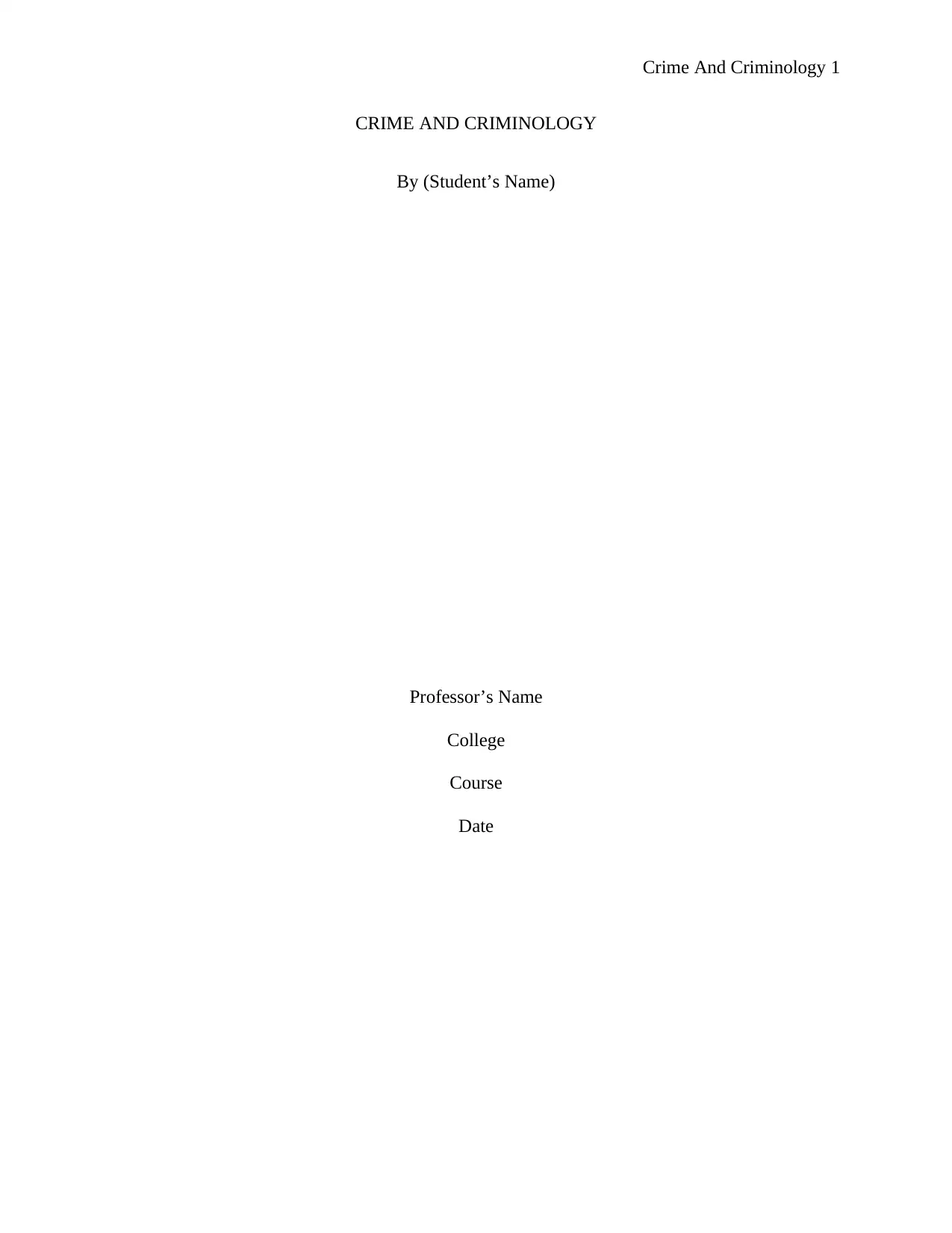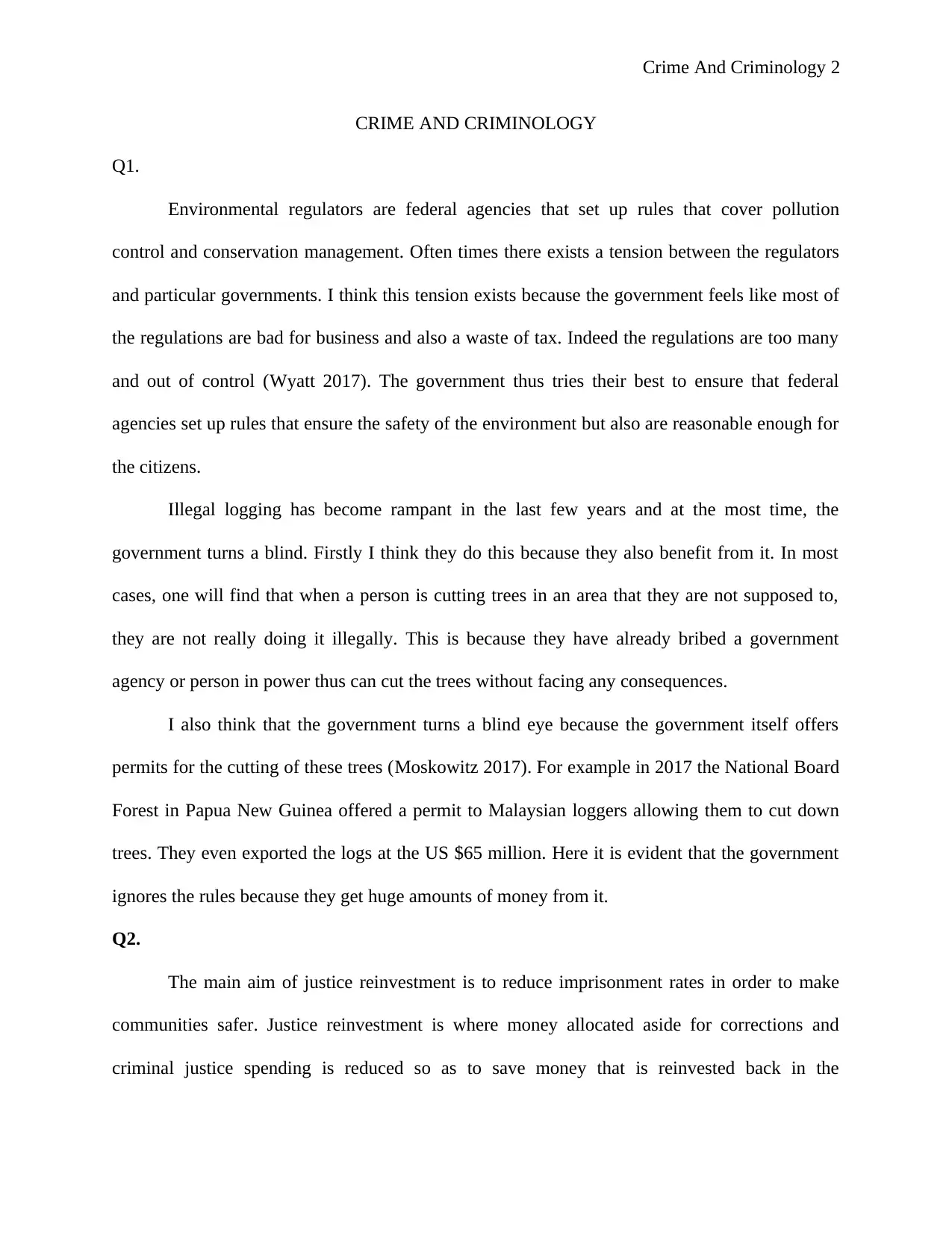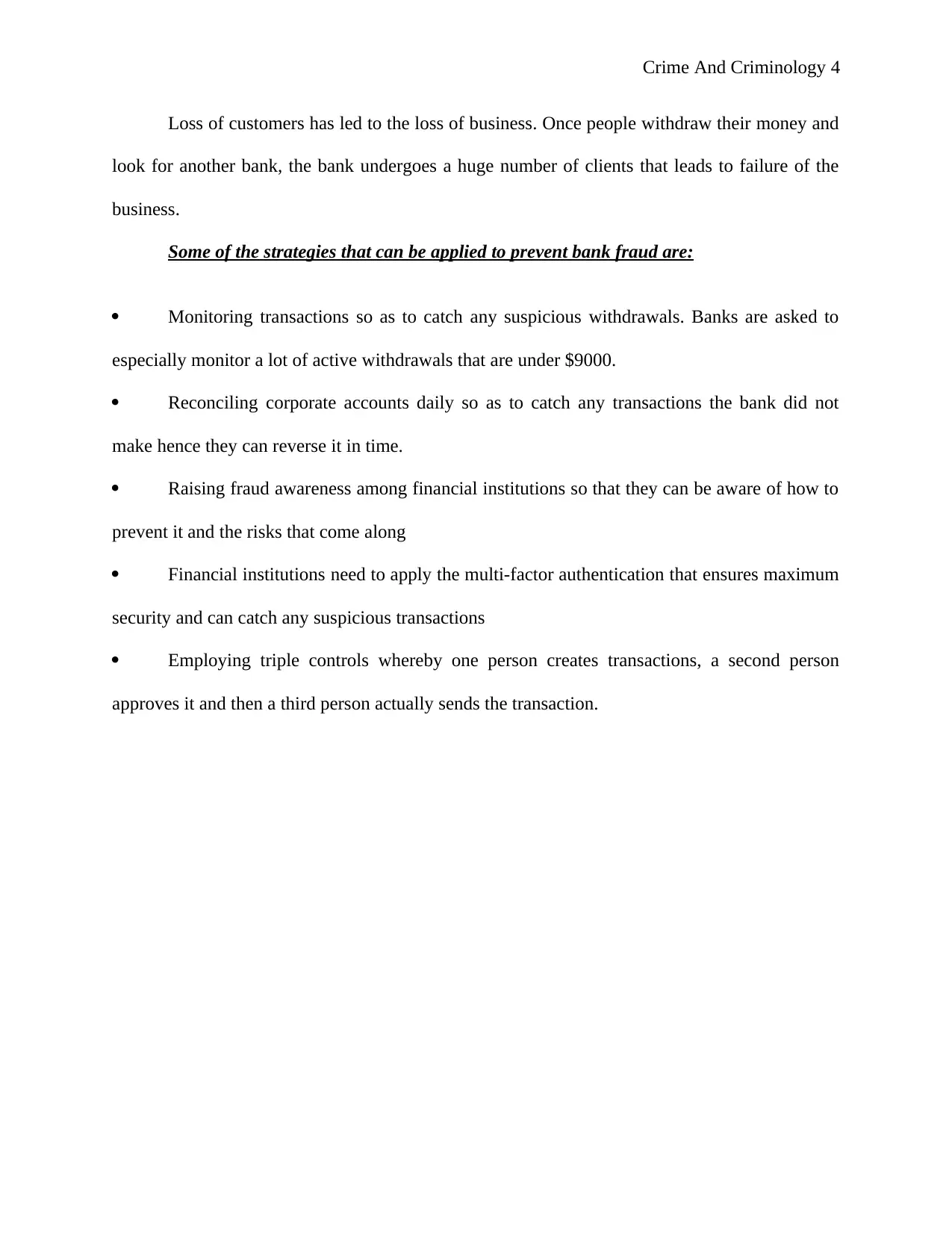Crime and Criminology Assignment: Financial Crime and Solutions
VerifiedAdded on 2021/06/14
|5
|1043
|29
Homework Assignment
AI Summary
This assignment on crime and criminology addresses several key issues. It begins by examining the tension between environmental regulators and governments regarding pollution control and conservation, particularly focusing on illegal logging and governmental involvement. The assignment then explores justice reinvestment strategies aimed at reducing imprisonment rates by reallocating resources to community-based crime prevention. Further, it discusses the challenges faced by Indigenous Australians in interacting with the criminal justice system due to cultural factors and lack of support. Finally, the assignment analyzes the rise of financial crime, including bank fraud, and proposes strategies such as transaction monitoring, account reconciliation, fraud awareness, multi-factor authentication, and triple controls to mitigate these risks. The assignment draws on several academic sources to support its arguments.

Crime And Criminology 1
CRIME AND CRIMINOLOGY
By (Student’s Name)
Professor’s Name
College
Course
Date
CRIME AND CRIMINOLOGY
By (Student’s Name)
Professor’s Name
College
Course
Date
Paraphrase This Document
Need a fresh take? Get an instant paraphrase of this document with our AI Paraphraser

Crime And Criminology 2
CRIME AND CRIMINOLOGY
Q1.
Environmental regulators are federal agencies that set up rules that cover pollution
control and conservation management. Often times there exists a tension between the regulators
and particular governments. I think this tension exists because the government feels like most of
the regulations are bad for business and also a waste of tax. Indeed the regulations are too many
and out of control (Wyatt 2017). The government thus tries their best to ensure that federal
agencies set up rules that ensure the safety of the environment but also are reasonable enough for
the citizens.
Illegal logging has become rampant in the last few years and at the most time, the
government turns a blind. Firstly I think they do this because they also benefit from it. In most
cases, one will find that when a person is cutting trees in an area that they are not supposed to,
they are not really doing it illegally. This is because they have already bribed a government
agency or person in power thus can cut the trees without facing any consequences.
I also think that the government turns a blind eye because the government itself offers
permits for the cutting of these trees (Moskowitz 2017). For example in 2017 the National Board
Forest in Papua New Guinea offered a permit to Malaysian loggers allowing them to cut down
trees. They even exported the logs at the US $65 million. Here it is evident that the government
ignores the rules because they get huge amounts of money from it.
Q2.
The main aim of justice reinvestment is to reduce imprisonment rates in order to make
communities safer. Justice reinvestment is where money allocated aside for corrections and
criminal justice spending is reduced so as to save money that is reinvested back in the
CRIME AND CRIMINOLOGY
Q1.
Environmental regulators are federal agencies that set up rules that cover pollution
control and conservation management. Often times there exists a tension between the regulators
and particular governments. I think this tension exists because the government feels like most of
the regulations are bad for business and also a waste of tax. Indeed the regulations are too many
and out of control (Wyatt 2017). The government thus tries their best to ensure that federal
agencies set up rules that ensure the safety of the environment but also are reasonable enough for
the citizens.
Illegal logging has become rampant in the last few years and at the most time, the
government turns a blind. Firstly I think they do this because they also benefit from it. In most
cases, one will find that when a person is cutting trees in an area that they are not supposed to,
they are not really doing it illegally. This is because they have already bribed a government
agency or person in power thus can cut the trees without facing any consequences.
I also think that the government turns a blind eye because the government itself offers
permits for the cutting of these trees (Moskowitz 2017). For example in 2017 the National Board
Forest in Papua New Guinea offered a permit to Malaysian loggers allowing them to cut down
trees. They even exported the logs at the US $65 million. Here it is evident that the government
ignores the rules because they get huge amounts of money from it.
Q2.
The main aim of justice reinvestment is to reduce imprisonment rates in order to make
communities safer. Justice reinvestment is where money allocated aside for corrections and
criminal justice spending is reduced so as to save money that is reinvested back in the

Crime And Criminology 3
communities. It heavily relies on data so as to know where the crime is reoccurring in the
community so as to reinvest there and also why the crime is occurring. Justice reinvestment
believes that by investing locally where crime is being committed they can intervene early find
solutions to problems the individuals are facing thus preventing crime. Therefore, less crime
means less imprisonment (Testa 2017). It thus comes up with strategies in the communities that
will reduce the crime and strengthen them.
Q3.
The indigenous people in Australia more often than not prefer not going to the police
because interaction with the Criminal Justice system poses a problem to them. One of the reasons
why they do not prefer interacting is because of their culture. For example, in the case of
domestic violence a woman is most likely not going to report because, in their culture, the
husband is your partner for life no matter what. Another reason for not interacting is because
they are not of much help. As much as the indigenous woman reports violence and the husband
is arrested then who is going to feed her children since the husband was the family provider.
Thus imprisonment does not really help the family (Balan, Otto, Minasian and Aryal 2017).
Q4.
Financial crime has increased in the past year and has not only affected individuals but
also businesses and communities. Bank fraud has impacted the community at large in many
ways. First, it has caused loss of millions to the banks. Hackers steal millions of money from
banks causing some banks to close down or to even go bankrupt. It has caused lack of trust
between the individuals and the bank. If a bank is a victim of bank fraud the clients believe that
there information is not safe in that bank thus withdraw (Alawi 2014).
communities. It heavily relies on data so as to know where the crime is reoccurring in the
community so as to reinvest there and also why the crime is occurring. Justice reinvestment
believes that by investing locally where crime is being committed they can intervene early find
solutions to problems the individuals are facing thus preventing crime. Therefore, less crime
means less imprisonment (Testa 2017). It thus comes up with strategies in the communities that
will reduce the crime and strengthen them.
Q3.
The indigenous people in Australia more often than not prefer not going to the police
because interaction with the Criminal Justice system poses a problem to them. One of the reasons
why they do not prefer interacting is because of their culture. For example, in the case of
domestic violence a woman is most likely not going to report because, in their culture, the
husband is your partner for life no matter what. Another reason for not interacting is because
they are not of much help. As much as the indigenous woman reports violence and the husband
is arrested then who is going to feed her children since the husband was the family provider.
Thus imprisonment does not really help the family (Balan, Otto, Minasian and Aryal 2017).
Q4.
Financial crime has increased in the past year and has not only affected individuals but
also businesses and communities. Bank fraud has impacted the community at large in many
ways. First, it has caused loss of millions to the banks. Hackers steal millions of money from
banks causing some banks to close down or to even go bankrupt. It has caused lack of trust
between the individuals and the bank. If a bank is a victim of bank fraud the clients believe that
there information is not safe in that bank thus withdraw (Alawi 2014).
⊘ This is a preview!⊘
Do you want full access?
Subscribe today to unlock all pages.

Trusted by 1+ million students worldwide

Crime And Criminology 4
Loss of customers has led to the loss of business. Once people withdraw their money and
look for another bank, the bank undergoes a huge number of clients that leads to failure of the
business.
Some of the strategies that can be applied to prevent bank fraud are:
Monitoring transactions so as to catch any suspicious withdrawals. Banks are asked to
especially monitor a lot of active withdrawals that are under $9000.
Reconciling corporate accounts daily so as to catch any transactions the bank did not
make hence they can reverse it in time.
Raising fraud awareness among financial institutions so that they can be aware of how to
prevent it and the risks that come along
Financial institutions need to apply the multi-factor authentication that ensures maximum
security and can catch any suspicious transactions
Employing triple controls whereby one person creates transactions, a second person
approves it and then a third person actually sends the transaction.
Loss of customers has led to the loss of business. Once people withdraw their money and
look for another bank, the bank undergoes a huge number of clients that leads to failure of the
business.
Some of the strategies that can be applied to prevent bank fraud are:
Monitoring transactions so as to catch any suspicious withdrawals. Banks are asked to
especially monitor a lot of active withdrawals that are under $9000.
Reconciling corporate accounts daily so as to catch any transactions the bank did not
make hence they can reverse it in time.
Raising fraud awareness among financial institutions so that they can be aware of how to
prevent it and the risks that come along
Financial institutions need to apply the multi-factor authentication that ensures maximum
security and can catch any suspicious transactions
Employing triple controls whereby one person creates transactions, a second person
approves it and then a third person actually sends the transaction.
Paraphrase This Document
Need a fresh take? Get an instant paraphrase of this document with our AI Paraphraser

Crime And Criminology 5
References
Alawi, A. 2014. Cybercrimes, Computer Forensics and their Impact in Business Climate:
Bahrain Status. Research Journal of Business Management, 8: 139-156. Retrieved from
https://scialert.net/fulltext/?doi=rjbm.2014.139.156
Balan, S., Otto, J., Minasian, E. and Aryal, A., 2017. Data Analysis of Cybercrimes in
Businesses. Information Technology and Management Science, 20(1), 64-68.
Jayanthi, M. K., 2017. Strategic Planning for Information Security-DID Mechanism to befriend
the Cyber Criminals to assure Cyber Freedom. In Anti-Cyber Crimes (ICACC), 2017 2nd
International Conference on (pp. 142-147). IEEE.
Moskowitz, S., 2017. Cybercrime and Business: Strategies for Global Corporate Security.
Butterworth-Heinemann.
Testa, M. R., 2017. The Political Environment of Federal Rulemaking: An Analysis of Comment
Submissions on Regulatory Outcomes.
Wyatt, T., 2017. How corruption enables wildlife trafficking. Corruption, Natural Resources and
Development: From Resource Curse to Political Ecology, 154.
References
Alawi, A. 2014. Cybercrimes, Computer Forensics and their Impact in Business Climate:
Bahrain Status. Research Journal of Business Management, 8: 139-156. Retrieved from
https://scialert.net/fulltext/?doi=rjbm.2014.139.156
Balan, S., Otto, J., Minasian, E. and Aryal, A., 2017. Data Analysis of Cybercrimes in
Businesses. Information Technology and Management Science, 20(1), 64-68.
Jayanthi, M. K., 2017. Strategic Planning for Information Security-DID Mechanism to befriend
the Cyber Criminals to assure Cyber Freedom. In Anti-Cyber Crimes (ICACC), 2017 2nd
International Conference on (pp. 142-147). IEEE.
Moskowitz, S., 2017. Cybercrime and Business: Strategies for Global Corporate Security.
Butterworth-Heinemann.
Testa, M. R., 2017. The Political Environment of Federal Rulemaking: An Analysis of Comment
Submissions on Regulatory Outcomes.
Wyatt, T., 2017. How corruption enables wildlife trafficking. Corruption, Natural Resources and
Development: From Resource Curse to Political Ecology, 154.
1 out of 5
Your All-in-One AI-Powered Toolkit for Academic Success.
+13062052269
info@desklib.com
Available 24*7 on WhatsApp / Email
![[object Object]](/_next/static/media/star-bottom.7253800d.svg)
Unlock your academic potential
Copyright © 2020–2025 A2Z Services. All Rights Reserved. Developed and managed by ZUCOL.